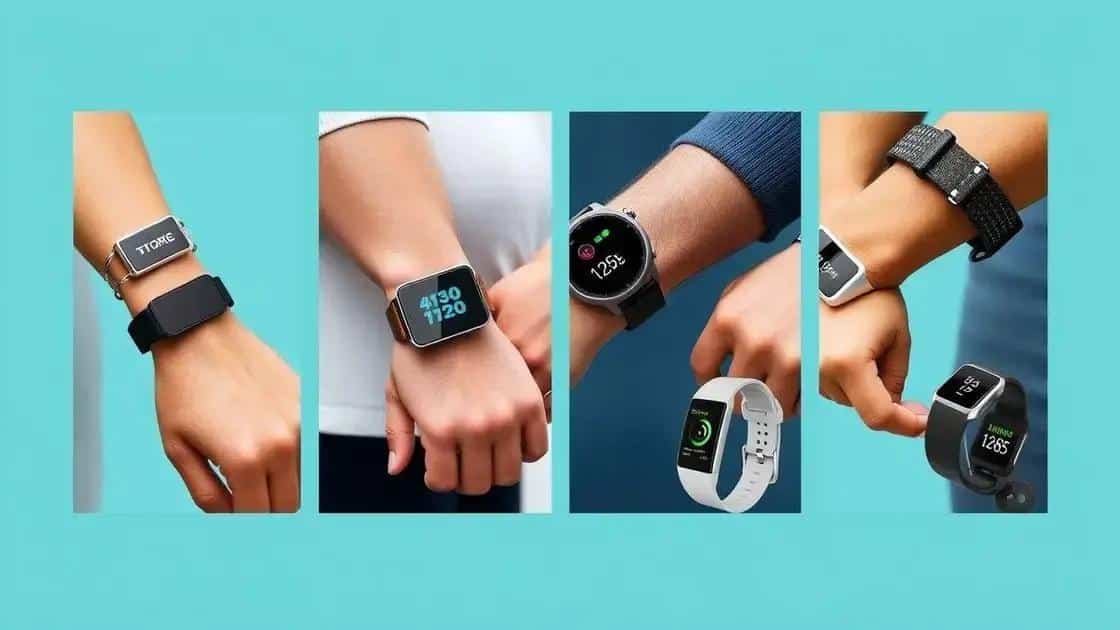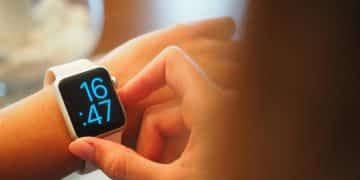Health tech advancements trends to watch in 2024

Wearable health devices are advanced technologies that monitor vital health metrics, enhance fitness tracking, and provide valuable health insights, enabling better personal health management.
Health tech advancements trends are rapidly changing how we approach medical care and patient experiences. Have you ever wondered how artificial intelligence and telemedicine are reshaping the landscape? Let’s dive into what’s trending and its implications.
Emerging technologies in health tech
As we delve into the world of emerging technologies in health tech, it’s essential to understand how these innovations are revolutionizing patient care and healthcare systems. New tools and platforms are changing the way healthcare providers deliver services, promoting efficiency and better health outcomes.
Key Technologies Shaping Health Tech
Several cutting-edge technologies have emerged, each contributing significantly to the transformation of health care.
- Artificial Intelligence: AI is streamlining operations, aiding diagnostics, and personalizing treatment plans.
- Telemedicine: This technology is allowing healthcare providers to interact with patients remotely, enhancing accessibility.
- Blockchain: It secures patient data and improves interoperability between different healthcare systems.
- Wearable Devices: Smartwatch technology is enabling constant monitoring of health metrics like heart rate and activity levels.
These technologies are not only enhancing patient engagement but also improving clinical workflows. For instance, AI-assisted tools help doctors analyze data more efficiently, leading to quicker diagnoses.
With the rise of telemedicine, patients can receive care from the comfort of their homes, especially during times when in-person visits may not be feasible. This has proven to be crucial during health crises, ensuring that individuals continue to receive necessary care without risking exposure.
Moreover, wearable technology empowers users to track their health conditions. Individuals can monitor vital signs in real time, leading to proactive management of their health. This level of engagement is changing patient dynamics and encouraging healthier lifestyles.
Future Trends to Watch
The landscape of health tech is evolving rapidly. Future trends indicate that integration of AI and machine learning will become standard practice in medical training and decision-making. We may also see an increased focus on personalized medicine, where treatment plans are tailored specifically to each individual’s genetic makeup.
Overall, the integration of emerging technologies into health care is a game changer. As these tools continue to develop, they hold the potential to not only improve individual health outcomes but also reshape the entire healthcare system into one that is more effective and responsive.
Impact of telemedicine on patient care

The impact of telemedicine on patient care is profound and wide-ranging. By leveraging technology, healthcare providers can now reach patients in ways that were previously unimaginable. This innovation is reshaping how patients access health services and engage with their care providers.
Benefits of Telemedicine
Telemedicine brings numerous advantages that improve patient experiences.
- Accessibility: Patients in remote or underserved areas can receive care without the need for long travel.
- Convenience: Appointments can be scheduled from the comfort of home, making it easier for busy families to see a doctor.
- Cost-Effectiveness: Telemedicine often reduces costs associated with travel and time off work.
- Continuity of Care: Follow-up visits can be done easily, ensuring better management of chronic conditions.
Such benefits create a more patient-centered approach to healthcare. For example, patients can now consult with specialists who may be located hundreds of miles away, directly connecting them to the expertise they need.
Moreover, telemedicine helps in monitoring ongoing health issues. Through virtual visits, doctors can assess a patient’s condition and adjust treatment plans without requiring them for an in-person visit. This method not only saves time but also encourages patients to stay engaged in their health management.
Challenges and Considerations
While the advantages are significant, there are also challenges to consider. Not every patient has access to the necessary technology or reliable internet. This digital divide can create disparities in care. Additionally, some patients may feel uncomfortable or less secure discussing health issues through a screen.
Despite these challenges, the future of telemedicine looks brighter. With ongoing advancements in technology and increasing acceptance among healthcare professionals, telemedicine continues to expand, reaching more patients every day.
How AI is transforming diagnostics
Artificial intelligence is significantly transforming diagnostics in healthcare. By employing advanced algorithms, AI systems can analyze medical data swiftly and accurately, leading to improved clinical decision-making.
How AI Enhances Diagnostic Accuracy
One of the primary ways AI contributes to diagnostics is by enhancing the accuracy of disease detection.
- Image Recognition: AI algorithms can analyze medical images, identifying patterns and anomalies that may go unnoticed by human eyes.
- Data Analysis: By processing vast amounts of patient data, AI can predict potential health issues before they manifest.
- Machine Learning: These systems continuously learn from new data, improving their diagnostic capabilities over time.
- Precision Medicine: AI can help tailor treatments based on individual patient profiles, leading to better outcomes.
The use of AI in areas like radiology and pathology is particularly noteworthy. For example, AI systems can assist radiologists in detecting tumors in mammograms with remarkable precision. The integration of these technologies not only speeds up the diagnostic process but also ensures that patients receive timely and accurate care.
Moreover, AI’s ability to sift through electronic health records (EHRs) allows for better identification of trends and risks in patient populations. This data-driven approach enables healthcare providers to make informed decisions that are pivotal in disease management and prevention.
Future Implications of AI Diagnostics
Looking ahead, the role of AI in diagnostics is expected to expand. As technology advances, AI systems will become even more integrated into everyday clinical practices. This integration will further enhance the efficiency and effectiveness of healthcare delivery.
While the transition toward AI-driven diagnostics presents challenges, including ethical considerations and data privacy issues, the potential benefits for patient outcomes are immense. As these technologies continue to evolve, they promise a brighter future for healthcare diagnostics, allowing for quicker responses and tailored treatments for patients.
Trends in wearable health devices

The trends in wearable health devices are changing how we monitor our health every day. These devices are becoming more sophisticated and user-friendly, making it easier for individuals to track various health metrics from their wrists or on their bodies.
Popular Wearable Health Devices
Wearable technology has evolved significantly over the last few years. Some of the most popular health devices include:
- Fitness Trackers: These devices record physical activity, heart rate, and calories burned. They encourage users to meet their fitness goals.
- Smartwatches: Beyond telling time, smartwatches can monitor health metrics, manage notifications, and even facilitate communication.
- Heart Rate Monitors: Often found in fitness equipment and smartwatches, these devices provide real-time heart rate data, assisting users during workouts.
- Wearable ECG Monitors: These specialized devices track heart rhythms and can notify users of irregularities.
Each of these devices offers valuable insights into health and wellness. They help users become more aware of their bodies and encourage healthier lifestyles.
The data collected from wearable devices is not just for personal use; it can also be shared with healthcare providers. This data allows doctors to monitor patients’ progress and make informed decisions regarding treatment plans.
Future Innovations in Wearable Health Technology
Looking ahead, the future of wearable technology is promising. Innovations such as advanced sleep tracking, stress monitoring, and even chronic disease management are on the horizon. New devices will integrate artificial intelligence to give personalized health advice based on real-time data.
As these technologies improve, they will play a crucial role in preventive healthcare, potentially catching health issues before they become severe. Wearables will also become more integrated into telemedicine, allowing for continuous monitoring without regular visits to healthcare facilities.
Wearable health devices are changing the way we take care of ourselves. They provide easy ways to track our health and fitness. As technology continues to evolve, we can expect even more advanced features that help us manage our well-being, like stress tracking and sleep monitoring. By embracing these innovations, we not only enhance our lives but also improve our health through informed choices. The future of health monitoring is bright, and wearable devices are at the forefront of this exciting journey.
FAQ – Frequently Asked Questions about Wearable Health Devices
What types of health metrics can wearable devices track?
Wearable devices can track various health metrics including heart rate, activity levels, sleep quality, and even stress levels.
How can wearable devices improve my health?
They can help you stay informed about your health, encourage regular physical activity, and provide insights that lead to healthier lifestyle choices.
Are wearable health devices effective for chronic disease management?
Yes, they can assist in managing chronic diseases by monitoring health data and providing crucial information to healthcare providers.
Do I need to connect my wearable device to a smartphone?
While many wearable devices can function independently, connecting to a smartphone often enhances their capabilities by allowing data synchronization and access to more features.






